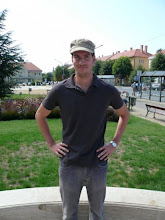The
Imperial palace (in Tokyo) - the Emperor's castle.
Some background information:
The Emperors have utmost importance for Japan. Let's see some interesting facts about it:
- the current Emperor is His Imperial Majesty of the Emperor Akihito who has been on the Throne since his father Hirohito died in 1989.
- the family of the Japanese emperors is the longest reigning family of the world with a history of more than 2000 (!!!) years. During this time, the lineage was never broken, there was always a male heir in the family despite wars, epidemics, etc (although in the old times one Emperor could have more wives, which helped in the children blessing).
- for most of the history in Japan, the Emperors had only symbolic roles. However, also several strong Emperors marked their sign in the Japanese history. Probably the most well-known is Emperor Meiji, who in 1868 toppled the samurai government (so-called
Meiji Restoration) and lead the modernization of Japan - in order to avoid the fate of China and the other Asian countries [this story was the basis of the film "
the last samurai"].
- Since always the same family reigned in Japan - they do not have a family name (!). You cannot say that for instance, Anjou, Hunyadi or Habsburg family, this had never had importance. Emperors are called on their own name.
- Even calculating the time starts with the reign of the Emperor. The current Emperor,
Akihito is the 125th Emperor and acceded to throne in 1989. His Japanese name is
Heisei, hence in 2008 we are in Heisei 20 according to Japanese calculation.

The Diet [Parliament] of Japan in Tokyo. Construction of the current Diet Building began in 1920 and was completed nearly 17 years later, in November 1936. The Diet consists of two chambers: the House of Representatives, or lower house, and the House of Councilors, or upper house - and well, as we heard from a presentation many heridetary MEPs in the Parliaments - if the father was a politician it is almost sure that the son will be as well.

Hiroshima dome -
Peace Memorial. The Atomic Bomb Dome is a skeletal domed building in Hiroshima City which still stands to commemorate the dropping of the atomic bomb. The atomic bomb, dropped for the first time in history, exploded some 580 meters above Hiroshima City. However, because the force of the blast came from almost directly above, part of the walls of the building and the steel frames of the dome on top survived and remained standing in the center of the burnt-out city area - basically that is the only building that survived the bomb in this area of hiroshime.
Therefore the damaged building was intentionally preserved in the state immediately after the bombing and eventually came to be called "Genbaku Dome (Atomic Bomb Dome)”, and is designated as the World Cultural Heritage as a symbol of the bombed city.
 Nijo-jo
Nijo-jo Castle, Kyoto. Nijo-jo was originally built in 1603 as the official Kyoto residence of the first Tokugawa Shogun, Ieyasu, the founder of Edo Government (Edo period (1603-1868)).
The ostentatious style of construction was intended as a demonstration of Ieyasu’ prestige and to signal the demise of the emperor’s power.
 Kinkaku-ji
Kinkaku-ji - Golden Temple.
Kinkaku-ji, formally named Rokuon-ji, was originally a villa of the Saionji family on the hills of Kitayama. In 1397, it was offered to the third Ashikaga Shogun, Yoshimitsu, but after his death, the villa was converted into a Buddhist temple.
The Temple is known as an epitome of Kitayama Culture. The Golden Pavilion, a gilded three-storied reliquary hall, is situated at the margin of a large pond named Kyokochi Pond. It is a typical architecture of the Muromachi Period (1333-1573).
The beautiful and luxurious aspect of the golden building is one of the most popular attractions in Kyoto not only among foreigners but also Japanese.
 Ginkaku-ji,
Ginkaku-ji, the Temple of Silver Pavilion.
Ginkaku-ji was built in 1482 originally to serve as a villa for the eighth Ashikaga Shogun, Yoshimasa, who took example from the golden Kinkaku-ji laid down by his grand father Yoshimitsu. Unlike Kinkaku-ji, which literally has golden appearance, though Ginkaku-ji, or “The temple of the Silver Pavilion”, is not covered in silver, it is called Ginkaku-ji in comparison with his grandfather’s one.
.




































































